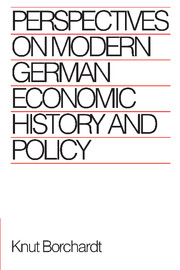Book contents
- Frontmatter
- Contents
- List of figures
- List of tables
- Preface to the English edition
- Preface to the German edition
- List of original chapter titles and first places of publication
- Abbreviations
- 1 Protectionism in historical perspective
- 2 Was there a capital shortage in the first half of the nineteenth century in Germany?
- 3 Regional variations in growth in Germany in the nineteenth century with particular reference to the west—east developmental gradient
- 4 Investment in education and instruction in the nineteenth century
- 5 Changes in the phenomenon of the business cycle over the last hundred years
- 6 Trends, cycles, structural breaks, chance: what determines twentieth-century German economic history?
- 7 The Federal Republic of Germany in the secular trend of economic development
- 8 Germany's experience of inflation
- 9 Constraints and room for manoeuvre in the great depression of the early thirties: towards a revision of the received historical picture
- 10 Economic causes of the collapse of the Weimar Republic
- 11 Germany's exchange rate options during the great depression
- Notes
- Index
5 - Changes in the phenomenon of the business cycle over the last hundred years
Published online by Cambridge University Press: 10 December 2009
- Frontmatter
- Contents
- List of figures
- List of tables
- Preface to the English edition
- Preface to the German edition
- List of original chapter titles and first places of publication
- Abbreviations
- 1 Protectionism in historical perspective
- 2 Was there a capital shortage in the first half of the nineteenth century in Germany?
- 3 Regional variations in growth in Germany in the nineteenth century with particular reference to the west—east developmental gradient
- 4 Investment in education and instruction in the nineteenth century
- 5 Changes in the phenomenon of the business cycle over the last hundred years
- 6 Trends, cycles, structural breaks, chance: what determines twentieth-century German economic history?
- 7 The Federal Republic of Germany in the secular trend of economic development
- 8 Germany's experience of inflation
- 9 Constraints and room for manoeuvre in the great depression of the early thirties: towards a revision of the received historical picture
- 10 Economic causes of the collapse of the Weimar Republic
- 11 Germany's exchange rate options during the great depression
- Notes
- Index
Summary
Striking shifts of focus are apparent in the development of economic thought in the twentieth century. From one decade to another, different themes stand at the centre of attention in economic conferences, and the subjects of contributions in economic journals change. One of the most striking examples is the change in interpretation of the phenomenon described by the concept of ‘business cycle’.
In the period between the two world wars, both the theory and empirical research into business cycles were among the most interesting areas of economics, characterised by a lively scientific progress. After 1950, however, the business cycle was discussed less and less as a problem of theoretical analysis. It became a kind of appendix to the theories of growth, of income, or of money. The booms and slumps of the fifties and sixties, which were on the whole relatively mild by comparison with those of the twenties and thirties, certainly contributed to the optimistic notion that both the theories and the instruments necessary to make growth permanent were available. The opinion that the business cycle no longer even existed was much canvassed. In several of the textbooks on macroeconomic theory in the sixties and early seventies, the term Konjunktur (business cycle) no longer appeared in the subject index.
- Type
- Chapter
- Information
- Publisher: Cambridge University PressPrint publication year: 1991



